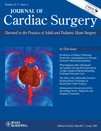Surgical Treatment of Infective Valve Endocarditis in Children with Congenital Heart Disease
Conflict of interest: The authors declared no conflicts of interest with respect to the authorship and/or publication of this article.
Funding: The authors received no financial support for the research and/or authorship of this article.
Abstract
Abstract Objective: This study assesses surgical procedures, operative outcome, and early and intermediate-term results of infective valve endocarditis in children with congenital heart disease. Methods: Seven consecutive children (five females, two males; mean age, 10.8 years) who underwent surgery for infective valve endocarditis between 2006 and 2010 were included in the study. The aortic and mitral valves were affected in two and tricuspid in five patients. Indications for operation included cardiac failure due to atrioventricular septal rupture, severe tricuspid valve insufficiency, and septic embolization in one, moderate valvular dysfunction with vegetations in three (two tricuspid, one mitral), and severe valvular dysfunction with vegetations in the other three patients (two tricuspid, one mitral). The pathological microorganism was identified in five patients. Tricuspid valve repair was performed with ventricular septal defect (VSD) closure in five patients. Two patients required mitral valve repair including one with additional aortic valve replacement. Results: There were no operative deaths. Actuarial freedom from recurrent infection at one and three years was 100%. Early echocardiographic follow-up showed four patients to have mild atrioventricular valve regurgitation (three tricuspid and one mitral) and three had no valvular regurgitation. No leakage from the VSD closure or any valvular stenosis was detected postoperatively. Conclusions: Mitral and tricuspid valve repairs can be performed with low morbidity/mortality rates and satisfactory intermediate-term results in children with infective valve endocarditis. (J Card Surg 2012;27:93-98)




